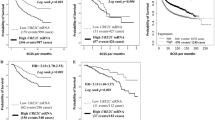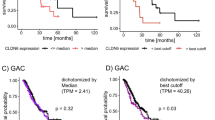Abstract
The ubiquitin proteasome pathway has been implicated in carcinogenesis. However, the role of E2-EPF ubiquitin carrier protein (UCP) in esophageal cancer remains relatively unstudied. In the study, we examined the mRNA level of circulating tumor cells from 60 esophageal cancer patients by membrane arrays consisting of a panel of potential markers including UCP, compared to 40 normal populations. The predictive capacity of UCP was also assessed by immunohistochemical staining of a retrospective series of 84 biopsied esophageal squamous cell carcinomas in relation to clinical outcome. In addition, we studied in vitro biological changes including tumor growth, metastatic capacity, and the sensitivity to irradiation and cisplatin, after experimental manipulation of UCP expression in esophageal cancer cells. By the data of 25-gene membrane array analysis, UCP was the only factor significantly associated with the extent of tumor burden in esophageal cancer patients. Our immunochemistry findings further indicate that UCP positivity was linked to poor response to neoadjuvant therapy and worse survival. In cell culture, inhibited UCP significantly decrease tumor growth and the capacity for metastasis. The epithelial–mesenchymal transition (EMT) induced by VHL/HIF-1α-TGF-β1 pathway might be the underlying mechanism responsible to the more aggressive tumor growth in UCP-positive esophageal cancer. Our results suggest that UCP was significantly associated with poor prognosis of esophageal cancer and may be a new molecular target for therapeutic intervention for esophageal squamous cell carcinoma.








Similar content being viewed by others
Abbreviations
- UCP:
-
E2-EPF ubiquitin carrier protein
- EMT:
-
Epithelial–mesenchymal transition
- VHL:
-
Von Hippel–Lindau gene
- HIF-1α:
-
Hypoxia-inducible factor-1α
- TGF-β1:
-
Transforming growth factor-beta 1
- VEGF:
-
Vascular endothelial growth factor
- EGFR:
-
Epidermal growth factor receptor
- HGF:
-
Hepatocyte growth factor
- PDGF:
-
Platelet-derived growth factor
- TS:
-
Thymidylate synthase
- ERCC1:
-
Excision repair cross-complementation group 1
- SIRT1:
-
The human homolog of the S. cerevisiae Sir2 protein
- PRDX-1:
-
Peroxiredoxin I
- COX-2:
-
Cycloxygenase-2
- ISG15:
-
Interferon-stimulated gene 15
- TOP-1:
-
Topoisomerase I
- TOP-2:
-
Topoisomerase IIa
- CK:
-
cytokeratin
References
Lee CH, Wu DC, Lee JM, Wu IC, Goan YG, Kao EL, Huang HL, Chan TF, Chou SH, Chou YP, Ho CK, Wu MT (2007) Anatomical subsite discrepancy in relation to the impact of the consumption of alcohol, tobacco and betel quid on esophageal cancer. Int J Cancer 120:1755–1762
Wu IC, Lu CY, Kuo FC, Tsai SM, Lee KW, Kuo WR, Cheng YJ, Kao EL, Yang MS, Ko YC (2006) Interaction between cigarette, alcohol and betel nut use on esophageal cancer risk in Taiwan. Eur J Clin Invest 36:236–241
Enzinger PC, Mayer RJ (2003) Esophageal cancer. N Engl J Med 349:2241–2252
Bedenne L, Michel P, Bouche O, Milan C, Mariette C, Conroy T, Pezet D, Roullet B, Seitz JF, Herr JP, Paillot B, Arveux P, Bonnetain F, Binquet C (2007) Chemoradiation followed by surgery compared with chemoradiation alone in squamous cancer of the esophagus: FFCD 9102. J Clin Oncol 25:1160–1168
Burmeister BH, Smithers BM, Gebski V, Fitzgerald L, Simes RJ, Devitt P, Ackland S, Gotley DC, Joseph D, Millar J, North J, Walpole ET, Denham JW (2005) Surgery alone versus chemoradiotherapy followed by surgery for resectable cancer of the oesophagus: a randomised controlled phase III trial. Lancet Oncol 6:659–668
Schwartz AL, Ciechanover A (1999) The ubiquitin–proteasome pathway and pathogenesis of human diseases. Annu Rev Med 50:57–74
Ciechanover A (1998) The ubiquitin–proteasome pathway: on protein death and cell life. Embo J 17:7151–7160
Pickart CM (2004) Back to the future with ubiquitin. Cell 116:181–190
Welsh JB, Zarrinkar PP, Sapinoso LM, Kern SG, Behling CA, Monk BJ, Lockhart DJ, Burger RA, Hampton GM (2001) Analysis of gene expression profiles in normal and neoplastic ovarian tissue samples identifies candidate molecular markers of epithelial ovarian cancer. Proc Natl Acad Sci U S A 98:1176–1181
Jung CR, Hwang KS, Yoo J, Cho WK, Kim JM, Kim WH, Im DS (2006) E2-EPF UCP targets pVHL for degradation and associates with tumor growth and metastasis. Nat Med 12:809–816
Tedesco D, Zhang J, Trinh L, Lalehzadeh G, Meisner R, Yamaguchi KD, Ruderman DL, Dinter H, Zajchowski DA (2007) The ubiquitin-conjugating enzyme E2-EPF is overexpressed in primary breast cancer and modulates sensitivity to topoisomerase II inhibition. Neoplasia 9:601–613
Whitfield ML, George LK, Grant GD, Perou CM (2006) Common markers of proliferation. Nat Rev Cancer 6:99–106
Wu CH, Lin SR, Yu FJ, Wu DC, Pan YS, Hsieh JS, Huang SY, Wang JY (2006) Development of a high-throughput membrane-array method for molecular diagnosis of circulating tumor cells in patients with gastric cancers. Int J Cancer 119:373–379
Wang JY, Lin SR, Wu DC, Lu CY, Yu FJ, Hsieh JS, Cheng TL, Koay LB, Uen YH (2007) Multiple molecular markers as predictors of colorectal cancer in patients with normal perioperative serum carcinoembryonic antigen levels. Clin Cancer Res 13:2406–2413
Chen MF, Fang FM, Lu CH, Lu MS, Chen WC, Lee KD, Lin PY (2008) Significance of nuclear accumulation of Foxo3a in esophageal squamous cell carcinoma. Int J Radiat Oncol Biol Phys 71:1220–1229
Hu CP, Hsieh HG, Chien KY, Wang PY, Wang CI, Chen CY, Lo SJ, Wuu KD, Chang CM (1984) Biologic properties of three newly established human esophageal carcinoma cell lines. J Natl Cancer Inst 72:577–583
Cockman ME, Masson N, Mole DR, Jaakkola P, Chang GW, Clifford SC, Maher ER, Pugh CW, Ratcliffe PJ, Maxwell PH (2000) Hypoxia inducible factor-alpha binding and ubiquitylation by the von Hippel–Lindau tumor suppressor protein. J Biol Chem 275:25733–25741
Iwai K, Yamanaka K, Kamura T, Minato N, Conaway RC, Conaway JW, Klausner RD, Pause A (1999) Identification of the von Hippel–Lindau tumor-suppressor protein as part of an active E3 ubiquitin ligase complex. Proc Natl Acad Sci U S A 96:12436–12441
Maxwell PH, Wiesener MS, Chang GW, Clifford SC, Vaux EC, Cockman ME, Wykoff CC, Pugh CW, Maher ER, Ratcliffe PJ (1999) The tumour suppressor protein VHL targets hypoxia-inducible factors for oxygen-dependent proteolysis. Nature 399:271–275
Pugh CW, Ratcliffe PJ (2003) Regulation of angiogenesis by hypoxia: role of the HIF system. Nat Med 9:677–684
Whitfield ML, Sherlock G, Saldanha AJ, Murray JI, Ball CA, Alexander KE, Matese JC, Perou CM, Hurt MM, Brown PO, Botstein D (2002) Identification of genes periodically expressed in the human cell cycle and their expression in tumors. Mol Biol Cell 13:1977–2000
Gunaratnam L, Morley M, Franovic A, de Paulsen N, Mekhail K, Parolin DA, Nakamura E, Lorimer IA, Lee S (2003) Hypoxia inducible factor activates the transforming growth factor-alpha/epidermal growth factor receptor growth stimulatory pathway in VHL(−/−) renal cell carcinoma cells. J Biol Chem 278:44966–44974
Gal A, Sjoblom T, Fedorova L, Imreh S, Beug H, Moustakas A (2008) Sustained TGF beta exposure suppresses Smad and non-Smad signalling in mammary epithelial cells, leading to EMT and inhibition of growth arrest and apoptosis. Oncogene 27:1218–1230
Sato M, Muragaki Y, Saika S, Roberts AB, Ooshima A (2003) Targeted disruption of TGF-beta1/Smad3 signaling protects against renal tubulointerstitial fibrosis induced by unilateral ureteral obstruction. J Clin Invest 112:1486–1494
Ananth S, Knebelmann B, Gruning W, Dhanabal M, Walz G, Stillman IE, Sukhatme VP (1999) Transforming growth factor beta1 is a target for the von Hippel-Lindau tumor suppressor and a critical growth factor for clear cell renal carcinoma. Cancer Res 59:2210–2216
Higgins DF, Kimura K, Bernhardt WM, Shrimanker N, Akai Y, Hohenstein B, Saito Y, Johnson RS, Kretzler M, Cohen CD, Eckardt KU, Iwano M, Haase VH (2007) Hypoxia promotes fibrogenesis in vivo via HIF-1 stimulation of epithelial-to-mesenchymal transition. J Clin Invest 117:3810–3820
Rees JR, Onwuegbusi BA, Save VE, Alderson D, Fitzgerald RC (2006) In vivo and in vitro evidence for transforming growth factor-beta1-mediated epithelial to mesenchymal transition in esophageal adenocarcinoma. Cancer Res 66:9583–9590
Lee JM, Dedhar S, Kalluri R, Thompson EW (2006) The epithelial–mesenchymal transition: new insights in signaling, development, and disease. J Cell Biol 172:973–981
Thiery JP (2002) Epithelial-mesenchymal transitions in tumour progression. Nat Rev Cancer 2:442–454
Gotzmann J, Mikula M, Eger A, Schulte-Hermann R, Foisner R, Beug H, Mikulits W (2004) Molecular aspects of epithelial cell plasticity: implications for local tumor invasion and metastasis. Mutat Res 566:9–20
Bates RC, Mercurio AM (2005) The epithelial–mesenchymal transition (EMT) and colorectal cancer progression. Cancer Biol Ther 4:365–370
Galliher AJ, Schiemann WP (2006) Beta3 integrin and Src facilitate transforming growth factor-beta mediated induction of epithelial–mesenchymal transition in mammary epithelial cells. Breast Cancer Res 8:R42
Cho HJ, Yoo J (2007) Rho activation is required for transforming growth factor-beta-induced epithelial-mesenchymal transition in lens epithelial cells. Cell Biol Int 31:1225–1230
Cho HJ, Baek KE, Saika S, Jeong MJ, Yoo J (2007) Snail is required for transforming growth factor-beta-induced epithelial-mesenchymal transition by activating PI3 kinase/Akt signal pathway. Biochem Biophys Res Commun 353:337–343
Kim MK, Cho KJ, Kwon GY, Park SI, Kim YH, Kim JH, Song HY, Shin JH, Jung HY, Lee GH, Choi KD, Kim SB (2008) ERCC1 predicting chemoradiation resistance and poor outcome in oesophageal cancer. Eur J Cancer 44:54–60
Wu X, Gu J, Wu TT, Swisher SG, Liao Z, Correa AM, Liu J, Etzel CJ, Amos CI, Huang M, Chiang SS, Milas L, Hittelman WN, Ajani JA (2006) Genetic variations in radiation and chemotherapy drug action pathways predict clinical outcomes in esophageal cancer. J Clin Oncol 24:3789–3798
Chen MF, Keng PC, Lin PY, Yang CT, Liao SK, Chen WC (2005) Caffeic acid phenethyl ester decreases acute pneumonitis after irradiation in vitro and in vivo. BMC Cancer 5:158
Rube CE, Uthe D, Schmid KW, Richter KD, Wessel J, Schuck A, Willich N, Rube C (2000) Dose-dependent induction of transforming growth factor beta (TGF-beta) in the lung tissue of fibrosis-prone mice after thoracic irradiation. Int J Radiat Oncol Biol Phys 47:1033–1042
Kovacs EJ (1991) Fibrogenic cytokines: the role of immune mediators in the development of scar tissue. Immunol Today 12:17–23
Andarawewa KL, Erickson AC, Chou WS, Costes SV, Gascard P, Mott JD, Bissell MJ, Barcellos-Hoff MH (2007) Ionizing radiation predisposes nonmalignant human mammary epithelial cells to undergo transforming growth factor beta induced epithelial to mesenchymal transition. Cancer Res 67:8662–8670
Tsukamoto H, Shibata K, Kajiyama H, Terauchi M, Nawa A, Kikkawa F (2007) Irradiation-induced epithelial-mesenchymal transition (EMT) related to invasive potential in endometrial carcinoma cells. Gynecol Oncol 107:500–504
Author information
Authors and Affiliations
Corresponding author
Electronic supplementary material
Below is the link to the electronic supplementary material.
ESM 1
(PDF 836 KB)
Rights and permissions
About this article
Cite this article
Chen, MF., Lee, KD., Lu, MS. et al. The predictive role of E2-EPF ubiquitin carrier protein in esophageal squamous cell carcinoma. J Mol Med 87, 307–320 (2009). https://doi.org/10.1007/s00109-008-0430-3
Received:
Revised:
Accepted:
Published:
Issue Date:
DOI: https://doi.org/10.1007/s00109-008-0430-3




